Most amateur golfers are unfamiliar with the concept of the lie angle. However, it is an important yet overlooked aspect of golf clubs. We will explain in plain terms what a golf club lie angle is and its types. We will show a standard golf club lie angle chart and the lie angle of best-selling golf club sets. Lastly, we will discuss how to measure it and the difference between men’s and women’s golf clubs angle.
What is a Golf Club Lie Angle?
The angle between the club’s sole and the shaft is called the golf club lie angle.


The lie angle of a golf club shapes how it interacts with the turf and consequently the golf ball flight. The impact of the lie angle is of paramount importance as it influences the trajectory of each shot.
Types of Lie Angles
There are three types of lie angles.
- Upright golf club angle
- Standard golf club angle
- Flat angle golf club angle


Upright Lie Angle
An upright golf club lie angle is when the toe of the golf club is raised higher than the heel. It is a steeper angle than the standard lie. It is ideal for taller golfers or upright swing players. It minimizes the slices. This configuration has a closed face at impact.
Standard Lie Angle
The standard angle serves as the baseline for most players. In this angle, the heel and toe (sole) of the golf club are at equal height. This is the men’s standard golf set configuration. The club makes a flush contact with the ground when the club length is properly fitted to the player’s height and stance.
Flat Lie Angle
A flat golf club lie angle is when the heel of the golf club is slightly raised higher than the toe. It is a somewhat flatter angle than the standard lie. A flat lie angle is perfect for shorter golfers or flat swing players. This configuration has an open face at impact.
Lie Angle Comparison Chart
The following is the lie angle comparison chart of upright, standard, and flat angles.
| Aspect | Upright Lie Angle | Standard Lie Angle | Flat Lie Angle |
|---|---|---|---|
| Sole Contact | Toe is elevated | Flush with the ground | Heel is elevated |
| Ideal Golfer Type | Taller, upright swing | Broad range of players | Shorter, flatter swing |
| Impact on Shots | Minimizes pushes/slices | Balanced performance | Reduces tendency to hook |
| Common Adjustments Needed | Flattening adjustments | Personalized fittings | Upright adjustments |
Golf Club Lie Angle Chart
The following is the standard golf club lie angle chart that most men’s and women’s golf sets are tuned to.
Men’s Standard Lie Angle


Longer irons have the lowest impact of lie angle whereas shorter irons have the highest impact of lie angle.


Women’s Standard Lie Angle


For women’s standard subtract one degree from the men’s standard lie.


Lie Angle of Best-Selling Golf Sets
The following table shows the standard lie angles of the best golf iron sets. These include TaylorMade Stealth Irons, Srixon ZX7 MK II Irons, TaylorMade P7MB Irons, Callaway Paradym Irons, Taylormade P790 Irons, and PING G430 Irons.


Golf Club Lie Angle Chart Measurement
One of the easiest and most practical methods is using your height and the wrist-to-floor measurement.


The following is a guide to help golfers understand and connect with the process:
Essentials Needed
| Golf Club | The club you plan to measure. |
| Yardstick or Tape Measure | For obtaining the wrist-to-floor measurement. |
| Friend or Golfing Buddy | A second set of eyes can make this process easier. |
8 Step Process
| Stand Naturally | Stand in your natural golf posture, with your feet shoulder-width apart and the club comfortably in your hands. |
| Grip the Club | Hold the club as you would during a swing. Ensure your hands are in a neutral position. |
| Alignment of Club Shaft | The club's shaft should align with your leading arm. This is usually your left arm for right-handed golfers and vice versa. |
| Check Your Posture | Ensure your spine is in a comfortable, natural position. Your posture should neither be overly upright nor excessively hunched. |
| Measurement Phase | Measure your height and ask your friend to measure the distance from the top of your wrist crease (where it bends) to the floor. Keep your arms hanging naturally for an accurate reading. |
| Compare it with Standard Measurements | Refer to standard measurements for lie angles based on your wrist-to-floor measurement. A shorter measurement may suggest a flatter lie angle. A longer measurement may indicate an upright lie angle. |
| Make Adjustments as Needed | If your lie angle does not align with the standard recommendations, consider adjustments. A golf course professional can help modify your club's lie angle to better suit your swing. |
| Test and Re-evaluate | Take the adjusted clubs to the range and assess how they feel during your swing. Make note of any improvements or adjustments needed for further fine-tuning. |
Based on the above-mentioned process, you can also refer to the Ping Color Code Chart.


Importance of the Lie Angle
The following is the breakdown of what could go wrong and what could go right when it comes to golf club lie angles.
What Could Go Wrong
| Issue | Description |
|---|---|
| Mis-Hits and Off-Center Shots | Incorrect lie angles can lead to mis-hits, causing shots to veer off the intended path. |
| Inconsistent Ball Flight | A misfit lie angle may result in inconsistent ball flight, making it challenging to predict outcomes. |
| Loss of Distance and Accuracy | Shots with an improper lie angle may lack the desired distance and accuracy, affecting overall play. |
| Directional Inconsistencies | An ill-fitted lie angle can contribute to directional inconsistencies, leading to frustration on the course. |
What Could Go Right
| Benefit | Description |
|---|---|
| Improved Accuracy and Precision | The correct lie angle promotes accurate and precise shots, contributing to a more controlled game. |
| Consistent Ball Flight | Optimal lie angles result in a consistent ball flight, providing golfers with better shot predictability. |
| Enhanced Distance Control | Well-fitted lie angles contribute to improved distance control, a crucial aspect of successful play. |
| Minimized Mis-Hits | Properly fitted lie angles minimize the occurrence of mis-hits, leading to a more satisfying golf experience. |
People Also Ask
How do I Know if the Lie Angle of My Golf Clubs is Correct for My Swing?
The best indicator is ball-flight consistency. If you are experiencing straight shots without excessive fading or drawing, and your divots are centered, your lie angle is likely well-suited to your swing.
Can I Adjust the Lie Angle of My Existing Clubs, or Do I Need to Buy New Ones?
Yes, lie angles can be adjusted. A professional club fitter can modify your current clubs to better match your swing characteristics, saving you the expense of purchasing new equipment.
How Often Should I Check and Adjust the Lie Angle of My Golf Clubs?
Unless your body is in the transforming phase, you do not need to check it regularly. However, it is advisable to check your lie angles periodically if you notice changes in your swing or performance. Adjustments may be needed due to alterations in your swing mechanics over time.
Can a Custom Lie Angle Improve My Accuracy, Even if I am not a Professional Golfer?
Yes, customizing your lie angles based on your swing and body characteristics can significantly improve accuracy and consistency.
What Happens if I Ignore the Lie Angle and Continue Using Improperly Fitted Clubs?
Using clubs with incorrect lie angles can lead to mis-hits, direction inconsistencies, and a lack of precision. Over time, this may impede your progress and enjoyment on the golf course.
Does Shaft Flex Matter in Lie Angle?
No, shaft flex and lie angle are distinct features. They do not hold any relationship.
All golfers regardless of their skill level should have ample knowledge about clubs including golf club lie angle charts and length charts.
Read More:
How Many Dimples Are on a Golf Ball
Iron Distance Chart
Golf Ball Diameter





